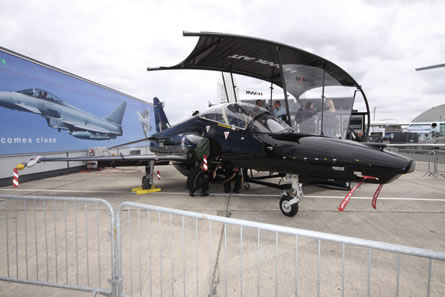BAE Systems has brought its Hawk advanced jet trainer to the show with hopes of extending a programme that has already delivered around 900 aircraft and trained an estimated 20,000 pilots worldwide.
The company's top priority is to conclude teaming arrangements for the US Air Force's T-X competition, which will seek at least 350 aircraft to replace its Northrop T-38C Talons.
 |
|---|
Billypix © |
To enter the fray as a prime contractor, North American business BAE Systems Inc will use the 128/T2-standard aircraft as the basis for its proposal. Now in use with the UK Royal Air Force, the type's OC2 operating standard emulates the use of radar, electronic warfare and countermeasures equipment and a stores management system.
"We are in the process of selecting our industry team across the aircraft manufacturing side and for the ground-based training environment," said Bob Wood, BAE's T-X lead executive. "We are talking to several companies."
With the USAF seeking a largely off-the-shelf solution, the Hawk will face competition primarily from the Alenia Aermacchi M-346 and Korea Aerospace Industries/Lockheed Martin T-50. While these may be more agile in terms of their handling, Wood said BAE has "no concerns about meeting the performance requirements of the air force".
"One of the strengths of the Hawk is our ability to emulate the sensor suite of a fifth-generation fighter," he said. "With these, 'bandits' are killed beyond visual range and manoeuvering doesn't occur. That's where training needs to go."
BAE expects the USAF to issue a request for proposals in early 2012. "Achieving initial operating capability in the fourth quarter of 2017 is driving this procurement," Wood said.
Other near-term sales opportunities exist in Iraq, Oman and Saudi Arabia, while BAE also stands ready to offer the Hawk should the slow-moving Advanced European Jet Pilot Training deal fail to take off.
- All the latest news, images and video from the 2011 Paris air show
Source: Flight Daily News























